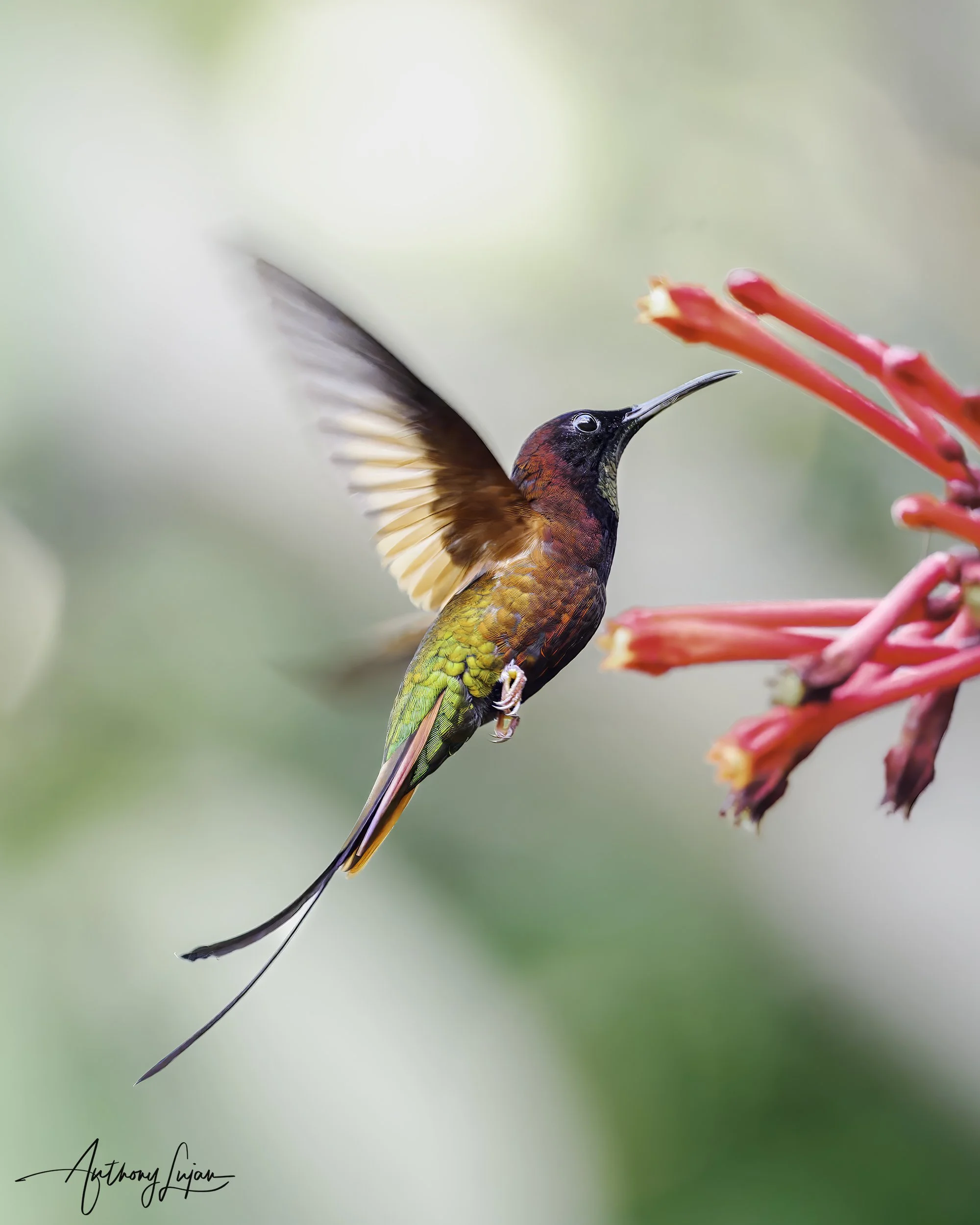Crimson Topaz
Crimson Topaz (Topaza pella)
Name Origin:
The genus name Topaza is derived from the gemstone topaz, referencing the dazzling metallic brilliance of these large Amazonian hummingbirds. The species name pella comes from the Greek pellos, meaning “dark-colored,” describing the deep red sheen of the bird’s plumage.
Quick Facts
🪶 Length: 20–23 cm (7.9–9.1 in), including tail
⚖️ Weight: 11–13 g (0.39–0.46 oz)
🌎 Range: Amazon Basin — Venezuela, Guyana, Suriname, French Guiana, Brazil, Peru, Ecuador
🧭 Elevation: Lowlands to 500 m (1,640 ft)
🌸 Diet: Nectar and small insects
🏡 Habitat: Lowland tropical rainforest, riverine forest, and forest edge
🧬 Clade: Topazini (primitive hummingbirds; the Topaz clade)
📊 Status: Least Concern (IUCN 2024)
Subspecies & Distribution
1. Topaza pella pella
Distribution: Found in eastern Venezuela, the Guianas, and northern Brazil, east of the Rio Negro and north of the Amazon River.
2. Topaza pella microrhyncha
Distribution: Occurs south of the Amazon River, in northern Brazil (from the lower Madeira east to Pará), and into northeastern Bolivia.
3. Topaza pella smaragdula
Distribution: Restricted to northeastern Brazil (Amapá region and lower Amazon delta).
Species Overview
The Crimson Topaz is a breathtakingly ornate hummingbird of the Amazon lowlands. It is among the largest of all hummingbirds, its iridescent red, gold, and green plumage earning it a reputation as the “jewel of the Amazon.” Preferring humid riverine and terra firme forests, it often perches high in the canopy or along forested rivers, flashing its brilliant plumage when it catches the light.
Male Description:
The male is iridescent crimson-red overall, with a golden-green crown and upper back, and a shining blackish-green throat patch bordered by golden reflections. The underparts are ruby to fiery red, and the long, deeply forked tail is velvety black with red gloss. The bill is long, straight, and black. In display, the male fans its tail and hovers to expose flashes of metallic color, often in sunlight near the canopy or riverside openings.
Female Description:
The female is smaller, with green upperparts, grayish underparts washed with red, and a shorter, less forked tail. She lacks the intense crimson iridescence and the long tail feathers of the male but retains a subtle coppery sheen on the flanks.
Habitat & Behavior:
The Crimson Topaz inhabits lowland rainforest, especially near rivers, forest clearings, and seasonally flooded várzea habitats. It feeds on nectar from Heliconia, Erythrina, and Inga flowers, often defending favored trees against other hummingbirds. It also gleans small insects in flight. Males perform energetic territorial displays with rapid dives and hovering postures, flashing their red plumage in sunlight.
Conservation Note:
The Crimson Topaz is listed as Least Concern by the IUCN. It remains widespread and locally common throughout the Amazon Basin. However, populations are dependent on intact lowland rainforest, and deforestation along river corridors may threaten some local populations. Maintaining large tracts of primary forest and riparian habitat is vital for the long-term health of this spectacular Topazini hummingbird.
Below is the Crimson Topaz (Topaza pella pella)
Photographed in Presidente Figueiredo, Amazonas, Brazil
This individual belongs to the nominate subspecies pella, which occurs throughout the Guianas and northern Brazil north of the Amazon River, including the Rio Negro region of Amazonas. It inhabits lowland rainforest, riverine forest, and forest edge along blackwater rivers, typically below 600 meters.





Checkout Anthony’s playlist of this species! Click the top right dropdown to see all the videos.

